Chicken liver parfait is one of those classic, retro appetizers that never really goes out of style. And it seems to be having a moment right now. I can't think of the last time I went to a trendy restaurant and this wasn't on the menu - and it's easy to see why.
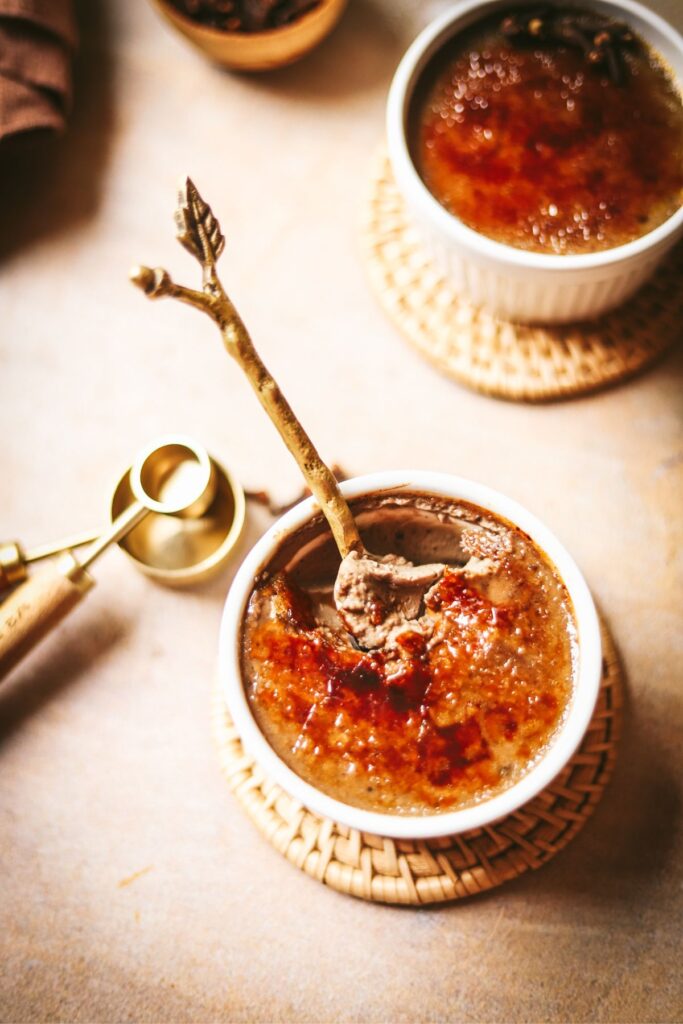
This appetizer's savory, creamy, and complex flavor make it a home run. Don't let the fact that it's liver scare you! I promise it's so delicious and will definitely impress any guest.
Discover the recipe for a divine brûléed chicken liver parfait on toasted brioche, a gourmet delight that will tantalize your taste buds.
Normally, chicken pate is made with butter or duck fat sealing the top, but we're switching this out for a crunch bruleed top that is to die for. Plus, we'll serve it alongside some bourbon cherries for an extra hit of sweetness that pairs well with the bourbon in the parfait itself.
Jump to:
Frequently Asked Questions
Pâté is a luxurious spread made from finely ground meat, typically liver, mixed with other ingredients like herbs, spices, and fat.
Pâté is often served as a spread on toasted bread or crackers. It can also be used in sandwiches, paired with pickles or chutneys, or incorporated into various recipes.
When prepared and cooked properly, pâté is safe to eat. It's important to ensure that the meat used is fresh, and the pâté is cooked to the recommended internal temperature to eliminate any potential foodborne pathogens.
The shelf life of pâté can vary. Generally, homemade pâté can be refrigerated for up to 3-5 days, while store-bought pâté may have a longer shelf life. Always check the packaging or consult the manufacturer's instructions for specific storage guidelines.
Yes, pâté can be frozen. It's best to wrap it tightly in plastic wrap or store it in a freezer-safe container. Frozen pâté can typically be kept for up to 2-3 months. Thaw it in the refrigerator before consuming.
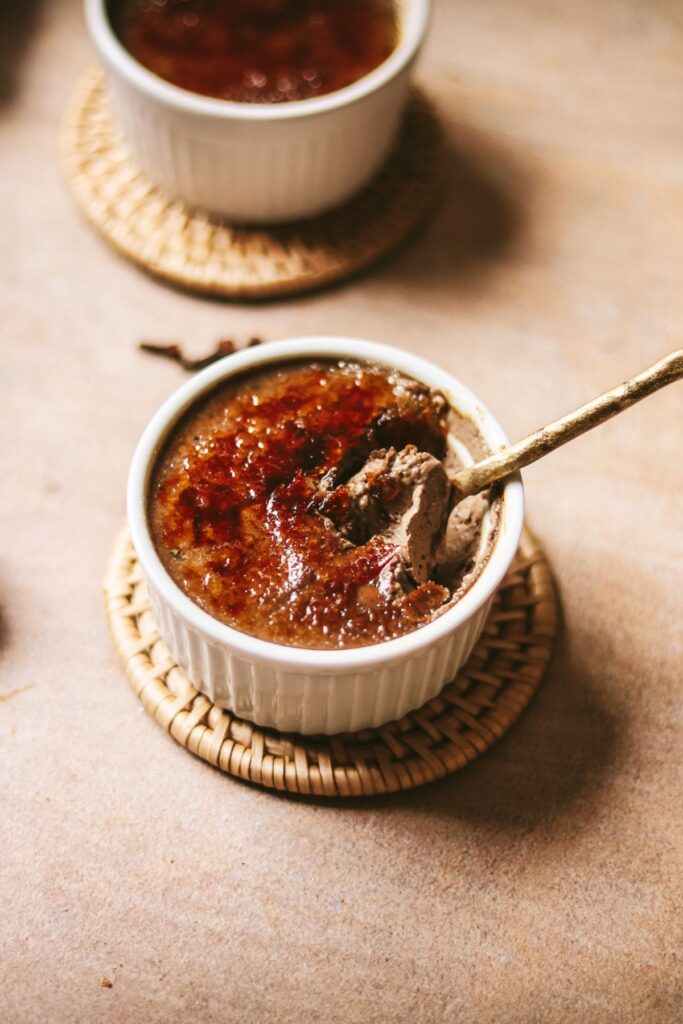
What is Pate?
It's a delectable spread made from cooked and blended chicken livers, combined with a medley of flavors. The process begins by sautéing finely chopped shallots or onions in butter or oil until they turn translucent and fragrant. Then, the chicken livers are added to the skillet and cooked until they are browned on the outside while still slightly pink on the inside.
Once cooked, the livers are transferred to a blender or food processor along with the sautéed shallots, a splash of brandy or cognac for a touch of sophistication, and an array of aromatic seasonings. This can include herbs like thyme, spices like allspice, nutmeg, and cloves, as well as salt and pepper to taste. A generous dollop of heavy cream is added to lend a luxurious and creamy texture to the pâté.
Blend until the mixture reaches a smooth and velvety consistency, adjusting the seasonings as needed. The resulting chicken liver pâté is then transferred to individual ramekins or a single serving dish, where it's chilled in the refrigerator for a couple of hours to allow it to set.
Serve the chicken liver pâté on toasted brioche or your preferred crusty bread. The rich, savory flavors of the pâté pair beautifully with the buttery brioche, creating a luxurious appetizer or a delightful addition to any charcuterie spread.
History and Origins
Pâté itself, including variations with chicken liver, can be traced back centuries ago to Europe, particularly France.
In medieval times, pâté was a dish reserved for the aristocracy and nobility, often enjoyed during lavish banquets and feasts. It was considered a symbol of wealth and indulgence. Pâté was initially made with a variety of meats, including game birds, pork, and veal. Over time, different regions and cultures developed their own unique styles and recipes.
The use of chicken liver in pâté became more prominent in France, where it gained popularity for its delicate flavor and smooth texture. The combination of sautéed chicken livers with fragrant herbs and spices, along with the addition of cream or butter, created a luxurious spread that delighted the palates of the upper class.
As culinary techniques and tastes evolved, chicken liver pâté made its way beyond the aristocratic circles and became more accessible to the general population. It found its place in French bistros, brasseries, and charcuterie shops, as well as in kitchens around the world where it continues to be enjoyed today.
The history of chicken liver pâté showcases the artistry and creativity of French cuisine, as well as its ability to transform humble ingredients into extraordinary culinary delights. So, as you savor each delectable bite of chicken liver pâté, remember the rich heritage and traditions that have shaped this beloved gourmet treat.
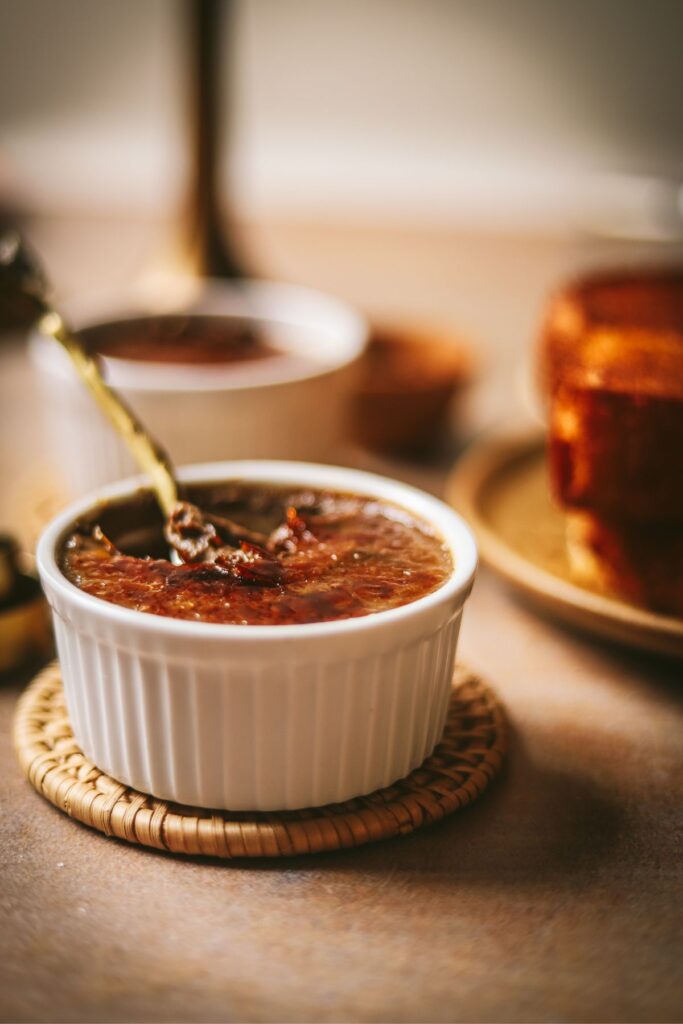
Parfait vs. Pate
Chicken liver parfait and pâté are essentially the same thing. Both refer to a creamy and smooth spread made from cooked and blended chicken livers, combined with various seasonings, herbs, and often enriched with cream or butter. The terms "parfait" and "pâté" are often used interchangeably to describe this delectable dish. I'm going to be using them interchangeably throughout this post as well!
Pate vs. Foie Gras
Parfait and foie gras may both feature luscious liver, but they each bring their own unique charms to the table. Parfait is a delightful creation crafted from various liver types, such as chicken or duck. It's all about that smooth and creamy texture that makes it irresistibly spreadable. Whip it up with a touch of cream or butter, and you have yourself a luxurious appetizer. Imagine savoring a heavenly bite of parfait, slathered on perfectly toasted bread or delicate crackers. It's the epitome of gourmet indulgence.
Now, let's talk about foie gras, the crème de la crème of liver delicacies. This extravagant treat specifically comes from the fattened liver of ducks or geese. The gavage process, where these birds are specially fed to encourage liver enlargement, results in a remarkably rich buttery texture. Foie gras practically melts in your mouth, leaving behind a velvety sensation that's second to none. This exquisite ingredient is often reserved for upscale culinary preparations, from elegant seared slices to decadent terrines. Foie gras truly embodies luxury dining at its finest.
So - to sum up, both are liver products, but pate is a dish made from chicken liver, while foie gras actually refers to the goose liver product itself. You can usually find it at restaurants in some sort of seared preparation, ready to smear on toast or crackers.
Ingredients
Chicken livers: The star of the show, chicken livers bring a rich and distinct flavor to the pâté. They have a smooth and creamy texture that lends itself perfectly to creating a luxurious spread.
Shallots: These aromatic ingredients add depth and savory notes to the pâté. They are sautéed to bring out their natural sweetness and enhance the overall flavor profile.
Butter or oil: Used for sautéing the shallots or onions and cooking the chicken livers, butter or oil helps to add richness and a luscious mouthfeel to the pâté.
Brandy or cognac: This elegant spirit provides a touch of sophistication and depth to the pâté. It complements the flavors of the chicken livers and adds a subtle warmth to the overall taste.
Herbs and spices (e.g., thyme, allspice, nutmeg, cloves): These flavorful additions bring complexity and aromatic notes to the pâté. Thyme offers earthiness, while spices like allspice, nutmeg, and cloves provide warmth and a hint of sweetness.
Salt and pepper: Essential for seasoning, salt and pepper bring balance and enhance the overall taste of the pâté.
Heavy cream: The addition of heavy cream adds richness, creaminess, and a silky smooth texture to the pâté. It helps create that irresistible spreadable consistency.
Sugar: The sugar in this recipe is typically used to create a caramelized crust on top of the pâté. It adds a delightful sweetness and a contrasting crunchy texture to complement the creamy pâté underneath.
Bourbon cherries: These delectable cherries, soaked in bourbon, make a luxurious accompaniment to the chicken liver pâté. The sweetness of the cherries and the rich undertones of bourbon create a delightful contrast to the savory pâté.
Toasted Brioche Bread: Pate served with toasted brioche is a top-of-the-line treat, but it's also delicious spread on just about anything: crackers, crostini, flatbreads, you name it. Go with whatever you want!
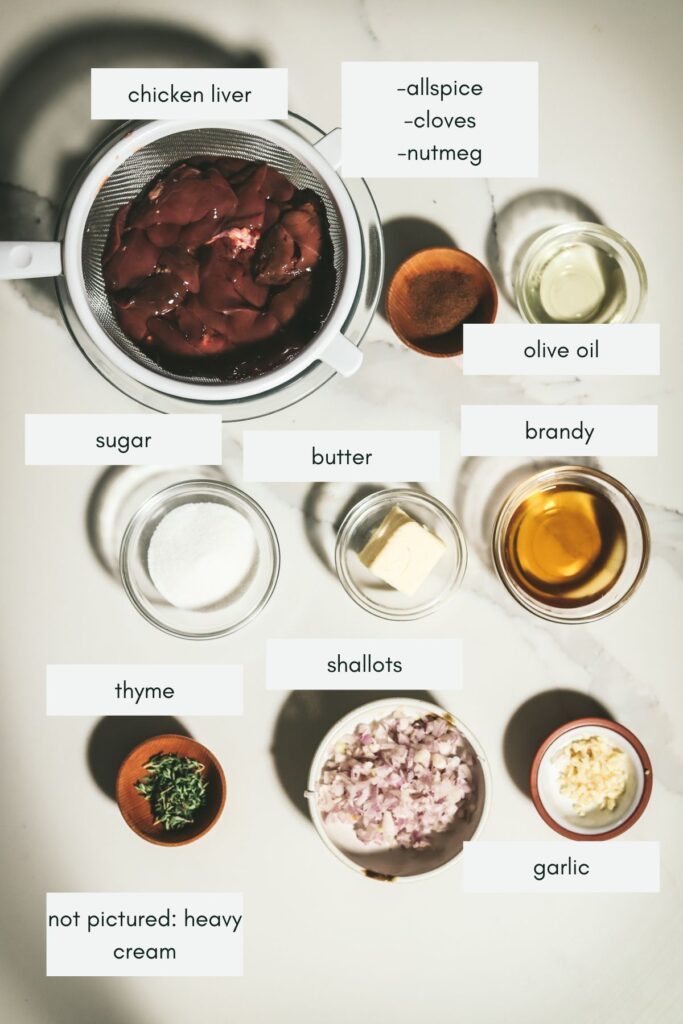
How to Make Chicken Liver Parfait
Ok, let's dive into this! Making the parfait is really not difficult, but there are a few steps we need to go though (plus, we get to brulee at the end, my favorite part!).
We'll finely chop those shallots and sauté them in a generous knob of butter.
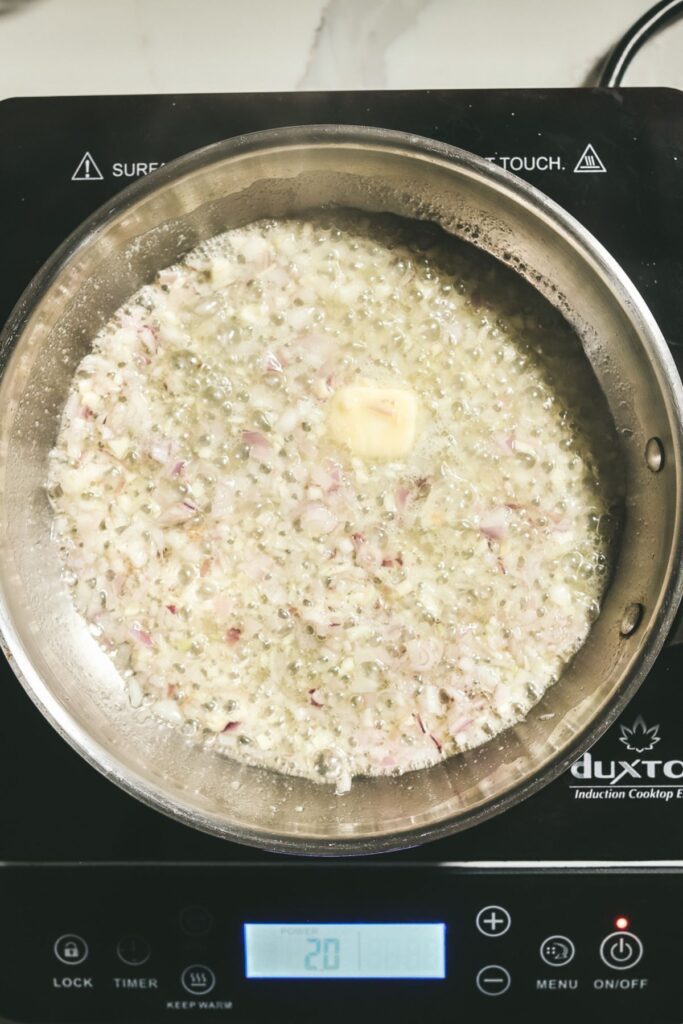
Once those shallots turn beautifully translucent and fragrant, it's time to add the star of the show – the chicken livers! Carefully place them in the skillet and let them sizzle away. We want them to develop a lovely golden-brown exterior while remaining slightly pink on the inside. That's the key to keeping the texture oh-so-smooth and velvety.
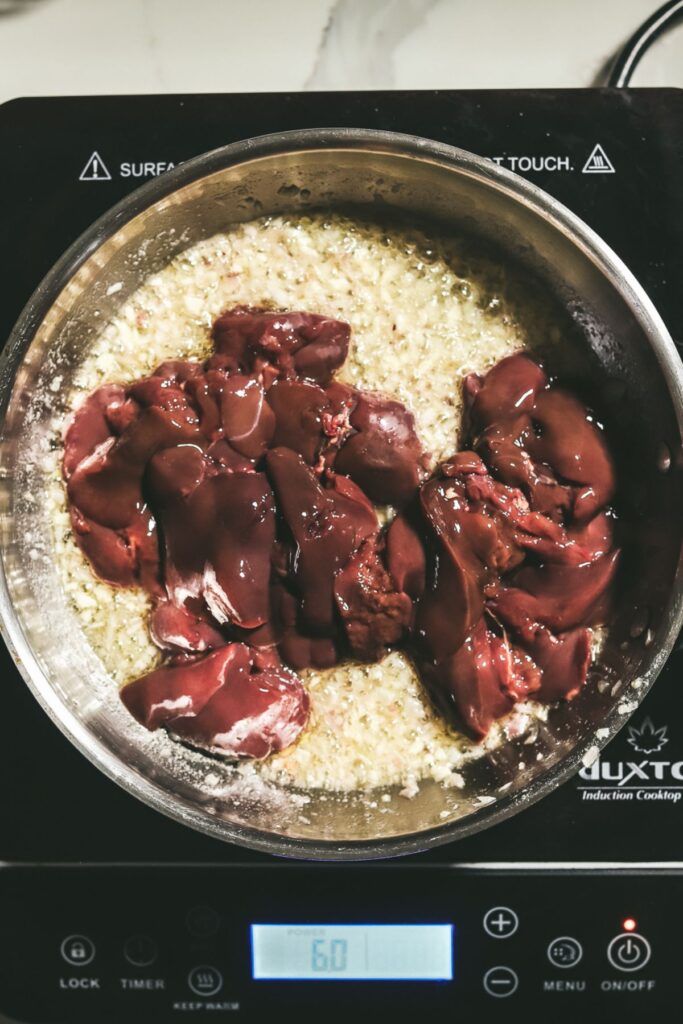
To perfect the seasoning, we'll sprinkle in the herbs and spices. A hint of thyme for earthiness, a dash of allspice, nutmeg, and cloves for warmth and a touch of sweetness. And of course, a little salt and pepper to bring everything together in perfect harmony.
Let's not forget the pièce de résistance – a splash of brandy or cognac. That touch of sophistication will elevate our chicken parfait to new heights of decadence. It adds a subtle depth and richness that will make every bite irresistible. Also - be careful! Adding the alcohol might start fire in the pan, especially if you're cooking on a gas stove. This is totally fine, just let it burn itself out, and don't get too close!
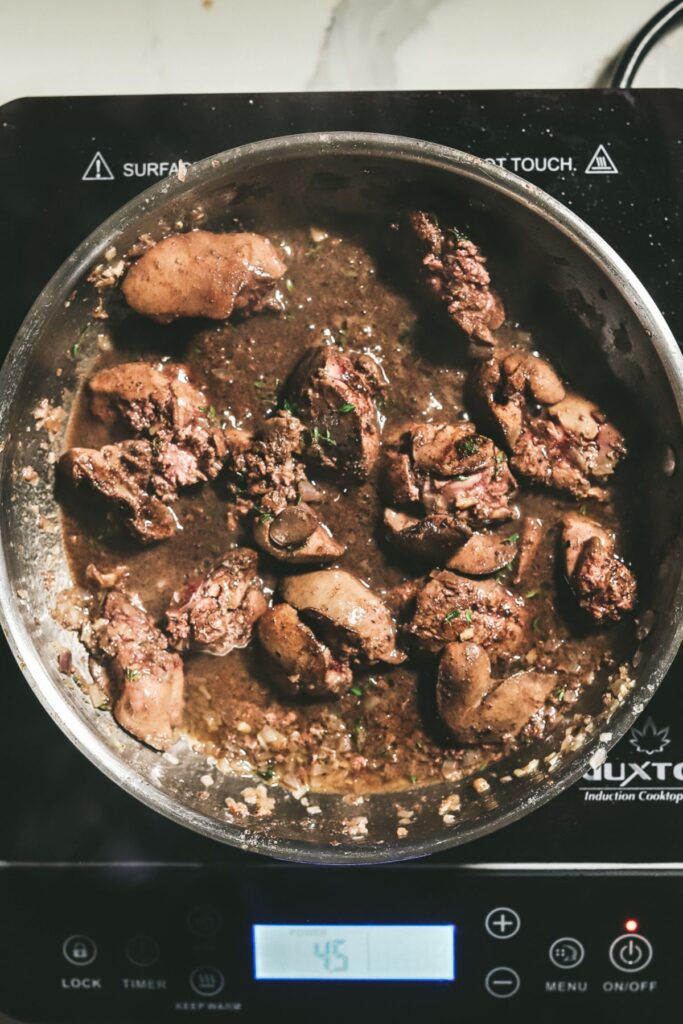
Let's transfer the cooked shallots and chicken livers to a trusty blender or food processor. We'll let it whirl until it becomes a silky-smooth mixture.
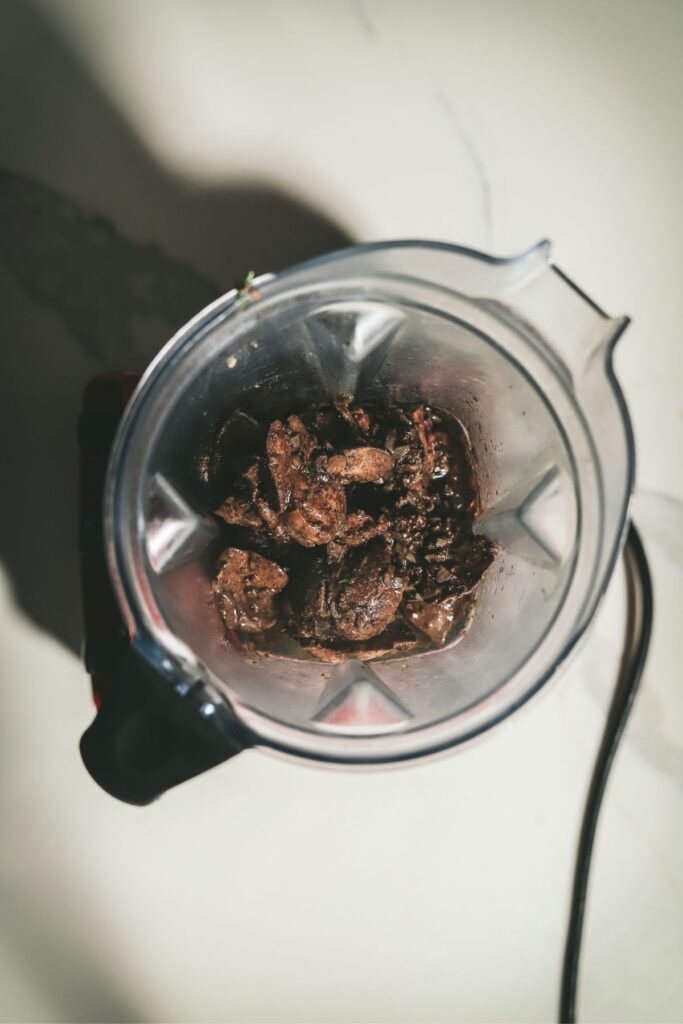
Add a generous dollop of heavy cream to our mixture. It will lend that richness and creaminess that will make our chicken parfait absolutely dreamy. Don't be shy; we're aiming for pure indulgence here!
Once our chicken parfait mixture is blended to perfection, we'll transfer it to individual ramekins or a single-serving dish. Pop them into the refrigerator and let them chill for a couple of hours. This will allow the flavors to meld together beautifully and the parfait to set into a luxurious consistency.

Sprinkle a thin layer of sugar on the surface of the chilled chicken parfait. Spread it evenly, making sure to cover the entire surface. Now, it's time for a little kitchen theatrics! Grab a culinary torch, and with steady hands, gently sweep the flame back and forth over the sugar. It should start to bubble and brown right away. Be careful not to burn it, though – we're aiming for a delicate brûlée, not a charred disaster (P.S. Check out the video below to see how this is done!).
When it's time to serve, we'll toast some brioche or crusty bread to perfection. The golden brown and buttery slices will be the perfect canvas for our chicken parfait. Spread that velvety goodness on top, and voilà – you're now basically a gourmet chef!
Accompaniments
Bourbon Cherries: We already discussed these delightful cherries earlier, and they would be a divine addition to your chicken liver parfait. The sweet and boozy cherries will provide a burst of flavor that beautifully complements the richness of the parfait.
Fig Jam: Spread a dollop of luxurious fig jam on the side of your serving plate. The jam's sweet and slightly earthy flavors will harmonize wonderfully with the savory notes of the chicken liver parfait, creating a tantalizing combination.
Caramelized Onions: Sauté some thinly sliced onions until they turn golden and caramelized. The sweet and savory nature of the caramelized onions will add depth and a touch of sweetness to your parfait, elevating the overall flavor profile.
Cornichons: These tangy, crunchy pickles are a classic accompaniment to pâtés and charcuterie. Their briny and acidic taste will provide a refreshing contrast to the richness of the chicken liver parfait, balancing the flavors beautifully.
Toasted Baguette Slices: Slice a fresh baguette into thin rounds, brush them with a little olive oil, and toast them until they turn golden and crispy. These delightful toast rounds will serve as the perfect vehicle for your chicken liver parfait, adding a delightful crunch and a neutral base to let the flavors shine.
Microgreens: Add a touch of elegance with some delicate microgreens as a garnish. Their vibrant colors and fresh flavors will not only enhance the visual appeal of the dish but also add a hint of freshness and a slight peppery note.
Wine Pairings
Sauternes: This luscious, sweet white wine from the Sauternes region of Bordeaux, France, is a classic match for foie gras and pâtés. Its honeyed richness, balanced acidity, and complex flavors of apricot, honey, and botrytis notes will beautifully complement the luxurious flavors and caramelized top of your chicken liver parfait.
Late Harvest Riesling: A late harvest Riesling with its natural sweetness and vibrant acidity can be an excellent companion to the richness of the chicken liver parfait. Look for a bottle with ripe stone fruit flavors, such as peach, apricot, and honey, which will harmonize with the flavors of the dish.
Pinot Noir: If you prefer a red wine pairing, opt for a delicate and fruity Pinot Noir. Its medium-bodied nature and red fruit flavors like cherry and raspberry will provide a lovely contrast to the creamy texture of the chicken liver parfait. Choose a Pinot Noir with balanced acidity and supple tannins for a harmonious pairing.
Champagne: When in doubt, Champagne is always a fab choice! The effervescence, crisp acidity, and toasty notes (often brioche, so a great pairing for this recipe!) of a good Champagne will cleanse the palate and enhance the flavors of the chicken liver parfait. Opt for a non-vintage Brut Champagne or a Blanc de Blancs for a delightful pairing.
Vin Jaune: For an adventurous pairing, consider Vin Jaune, a unique wine from the Jura region of France. This oxidative white wine offers nutty, savory flavors with hints of yellow fruits and a distinctive oxidative character. Its complexity and intense flavors will create an intriguing combination with the richness of the chicken liver parfait.
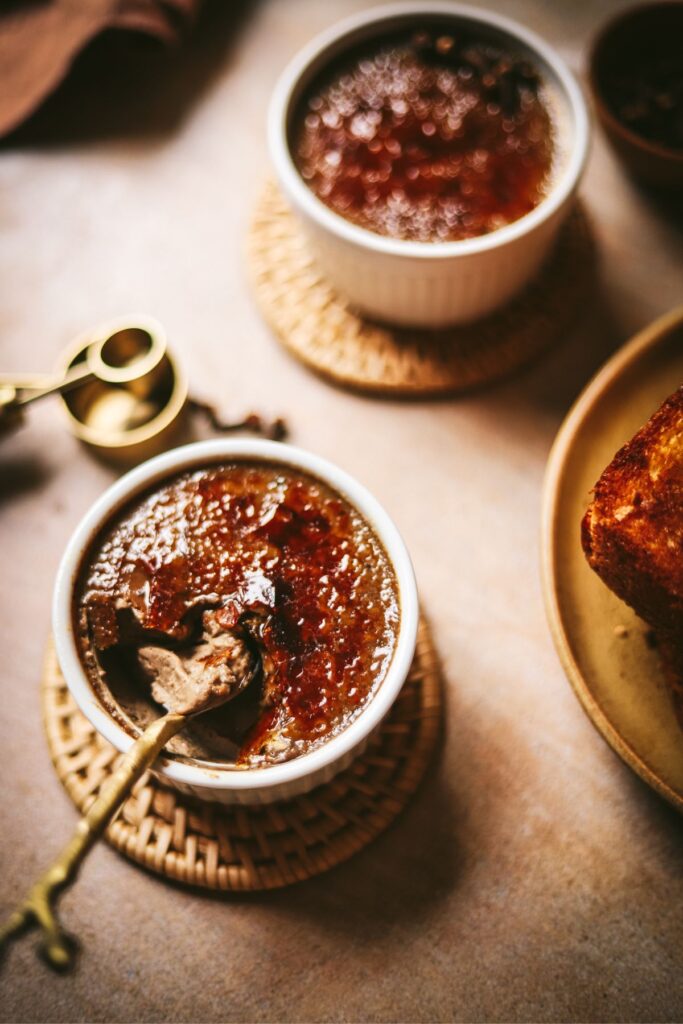
Freezing & Storage
- Storage: If you plan to consume the chicken liver parfait within a couple of days, store it in an airtight container in the refrigerator. Make sure the container is tightly sealed to prevent any odors from permeating the pâté. The parfait can be stored in the refrigerator for up to 3-4 days.
- Freezing: If you want to extend the shelf life of your chicken liver parfait, freezing is a great option. However, it's important to note that the texture may slightly change upon thawing.
- Before freezing, make sure the parfait has completely cooled down in the refrigerator.
- Transfer the parfait to a freezer-safe container, ensuring it is airtight and there is minimal empty space to avoid freezer burn.
- Label the container with the date and contents for easy identification.
- Place the container in the freezer and allow it to freeze for 1-2 hours, or until firm.
- Once frozen, you can keep the chicken liver parfait in the freezer for up to 2-3 months.
- Thawing: When you're ready to enjoy your frozen chicken liver parfait, it's important to thaw it properly to preserve its quality.
- Remove the container from the freezer and place it in the refrigerator overnight or for approximately 24 hours.
- Allow the parfait to thaw slowly in the refrigerator to maintain its texture and flavor.
- Once thawed, give it a gentle stir or whisk to restore its creamy consistency.
- You can then serve it chilled or let it come to room temperature before enjoying.
Other Awesome Appetizers
📖 Recipe
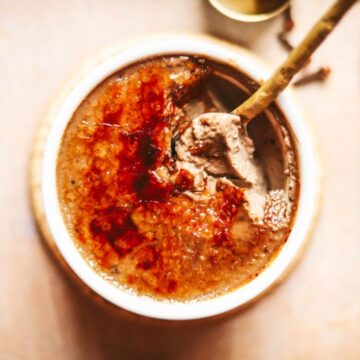
Chicken Liver Parfait with Toasted Bricohe
Equipment
- Blender or food processor
- Kitchen torch
Ingredients
- 1 C chicken livers trimmed
- 1 shallot minced
- 2 cloves garlic minced
- 2 tablespoon butter
- 1 tablespoon olive oil
- 2 tablespoon brandy or cognac
- 1 teaspoon thyme leaves
- ½ teaspoon allspice
- ¼ teaspoon cloves
- ⅛ teaspoon nutmeg
- ½ C heavy cream
- 4 slices brioche
- 2 tablespoon granulated sugar
- bourbon cherries optional
- 4 slices brioche bread toasted
Instructions
- In a large skillet, melt the butter and olive oil over medium heat. Add the finely chopped shallot and minced garlic. Sauté until they become translucent and fragrant, about 5 minutes.
- Increase the heat to medium-high and add the chicken livers to the skillet. Cook them for about 5 minutes, stirring occasionally, until they are browned on the outside but slightly pink on the inside.
- Reduce the heat to medium-low and add the brandy or cognac to the skillet. Be careful as the alcohol may ignite briefly. Stir in the thyme leaves, ground allspice, ground nutmeg, and ground cloves. Cook for an additional 2 minutes to allow the flavors to meld together.
- Remove the skillet from the heat and let the mixture cool for a few minutes. Transfer the contents of the skillet to a blender or food processor. Add the heavy cream, salt, and pepper. Blend until you achieve a smooth and creamy texture. Adjust the seasoning if needed.
- Pour the mixture into individual ramekins or a single serving dish. Smooth the top with a spatula. Refrigerate for at least 2 hours to allow the pâté to set.
- When ready to serve, preheat the oven to broil. Place the brioche slices on a baking sheet and toast them in the oven until golden brown on both sides.
- Sprinkle the tops of the chilled chicken liver parfait with granulated sugar. Using a culinary torch, carefully brûlée the sugar until it forms a caramelized crust.
- Serve the brûléed chicken liver parfait with the toasted brioche slices on the side. The pâté can be spread on the brioche or enjoyed separately. Serve alongside bourbon cherries, if using.
Video
Notes
Nutrition
Hi, I'm Cara! I'm a food writer, journalist, and recipe developer. I'm obsessed good food, good wine, good cocktails and entertaining. I've picked up a few tips over the years, and love sharing them with others.


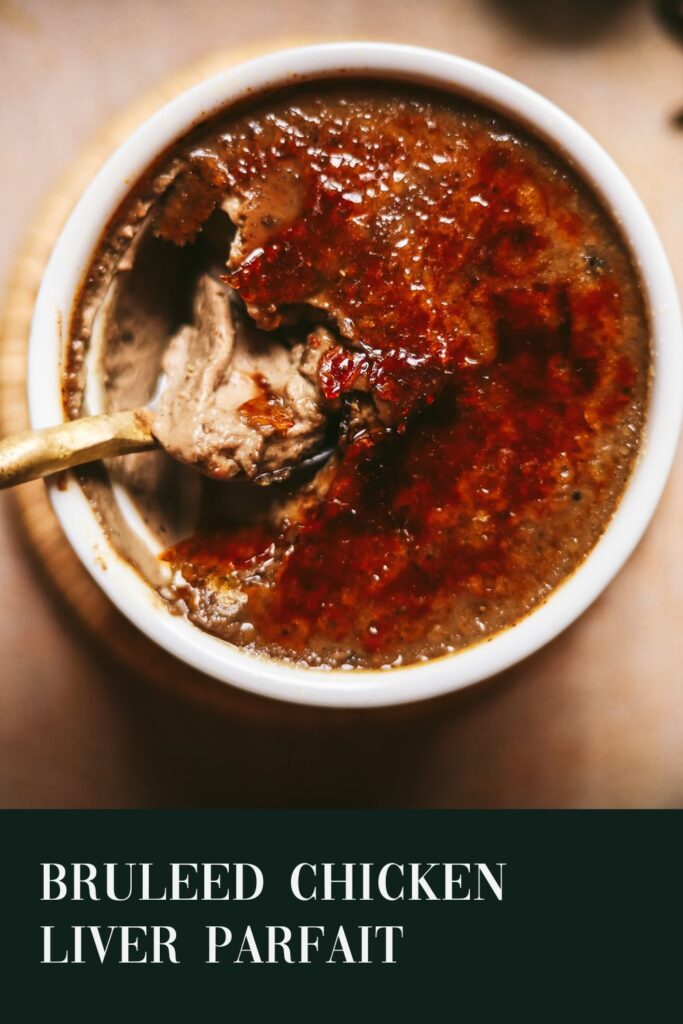
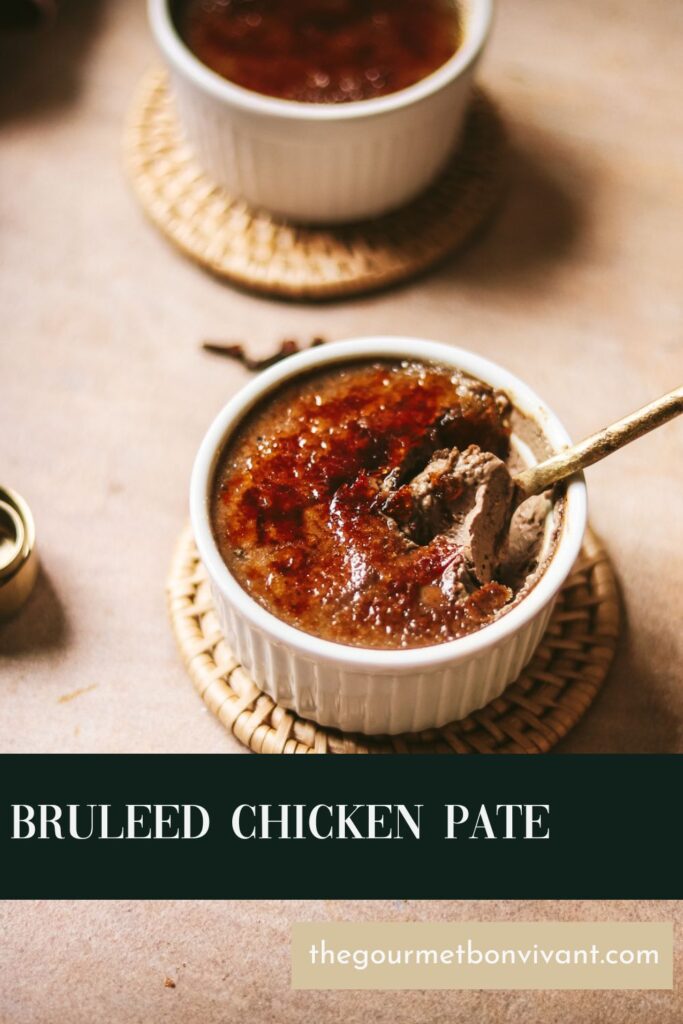
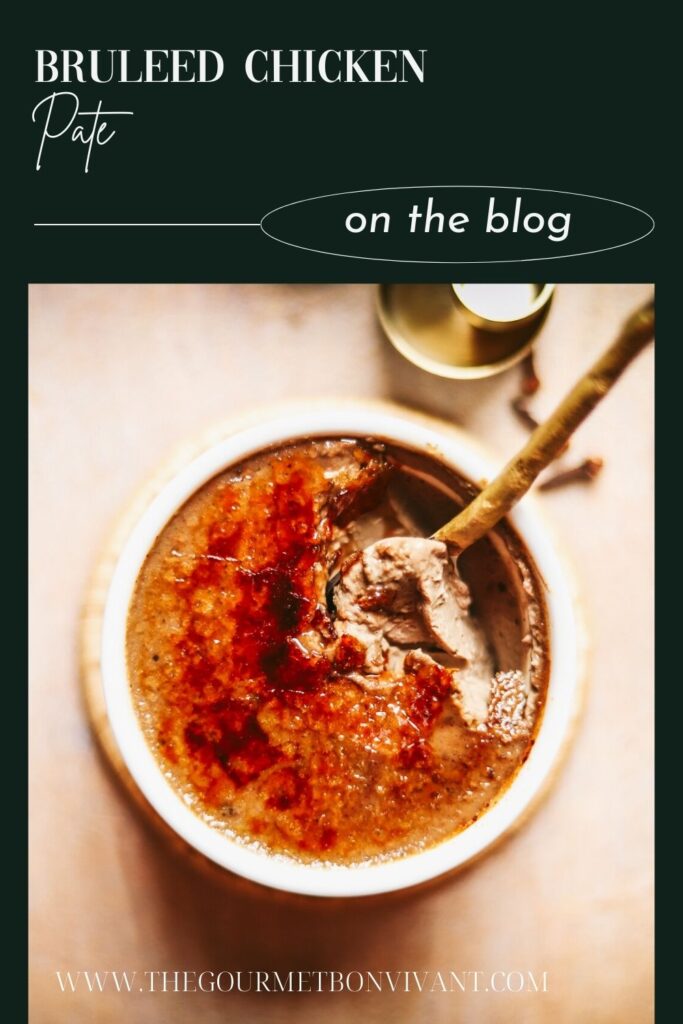
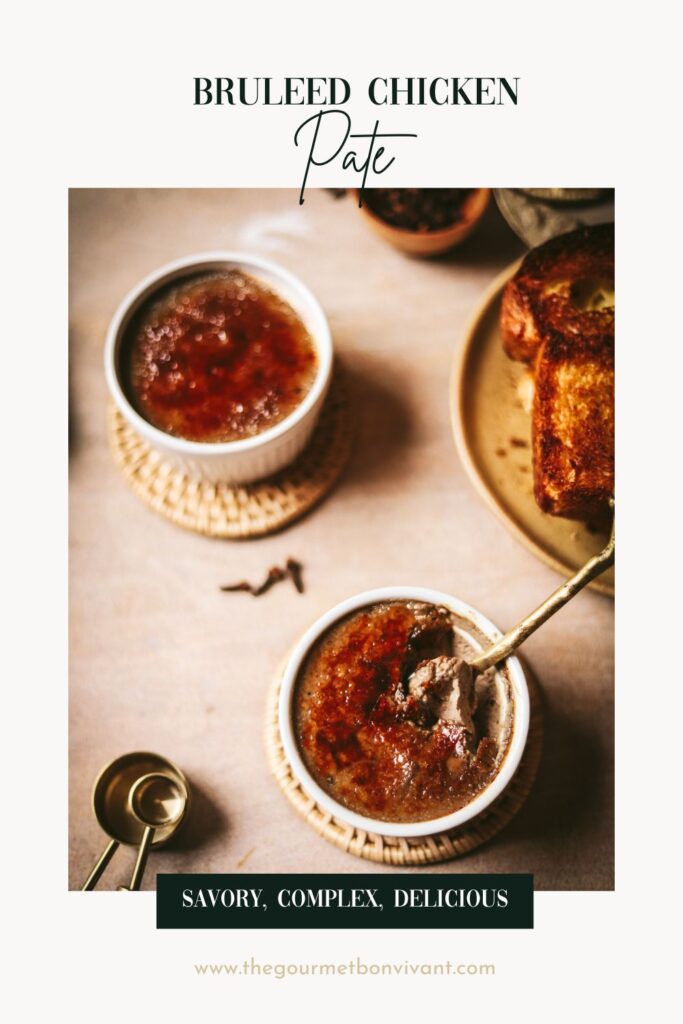
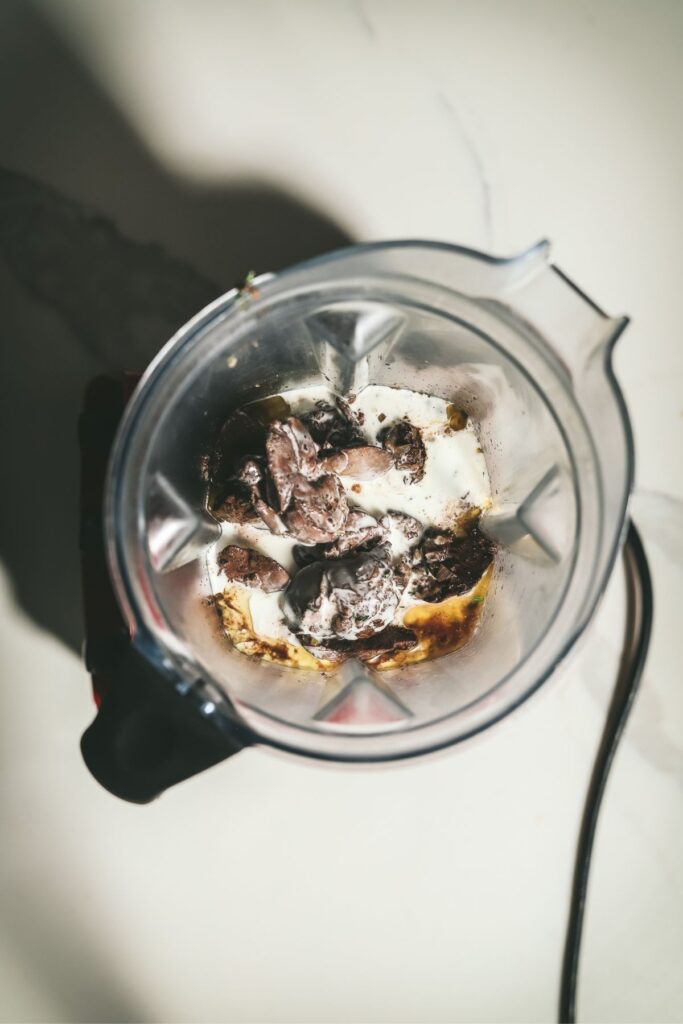
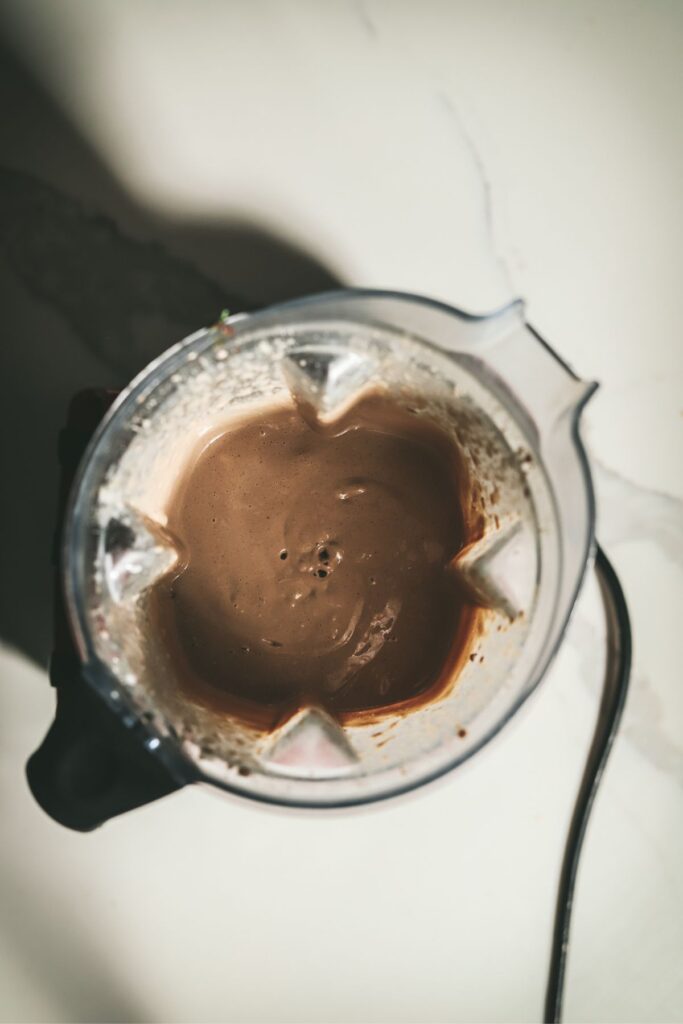



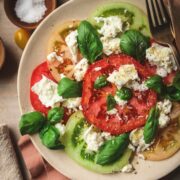

Leave a Reply